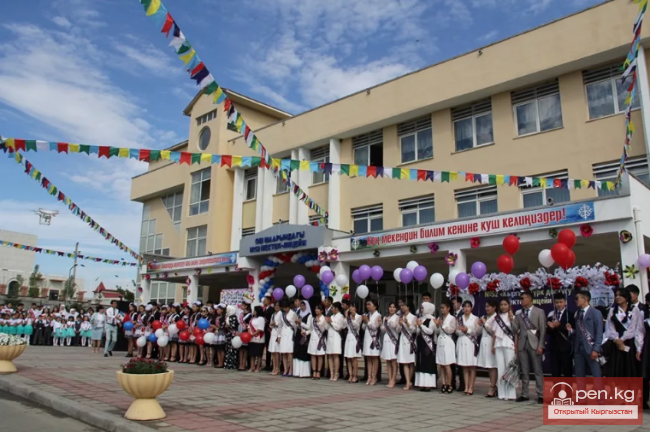The correspondent of Turmush provides information about the development of the educational sector...

Before the revolution, there were 107 Russian schools in Kyrgyzstan, where, in addition to Russian...
Residents of Kara-Kul have appealed to President Sadyr Japarov for the construction of an...

Vice Prime Minister Elvira Sarieva: “The opening of each new school building, especially in...

Primary Education in the City of Osh The city of Osh is not only a hub of industry but also a...
In response to the request[b] 24.kg[/b], the administration of the Karalaev School...
In the Issyk-Kul region, in the Ak-Suu district, an event was held dedicated to the anniversary of...
In the village of Sirt in the Kadamjay district, a kindergarten named "Chabalekey-Sirt"...
Over the next 25 years, 174 new schools are planned to be built in Bishkek, which is related to the...

In the photo: Second graders of the "Olymp" primary school in Osh during a Russian...
In the capital district of Ak-Ordo, the construction of a new school for 750 students has begun, as...
In the village of Zher-Uy in the Ton district of the Issyk-Kul region, the construction of a new...

It is known that in the 18th century, the Kyrgyz, although rarely, used a new writing system, as...

Education. By the time Soviet power was established in Kyrgyzstan, its population was completely...

According to the results of the city olympiad, School No. 61 leads in the number of prize-winning...

Kulte Mark Alekseevich Film director. Born on April 25, 1896, in the city of Bakhchisarai, Crimea,...
A new branch of school No. 40 has been launched in the capital, located in a residential complex...

FROM THE REPORT ON THE ACTIVITIES OF THE INDUSTRIAL SOCIETY "INTERGELPO" FOR 1925-1934...
In honor of the 90th anniversary of the outstanding sculptor Turgunbay Sadykov, who was awarded the...

Amanaliev Dzhusupbek (1932), Doctor of Pedagogical Sciences (1992), Professor (1994)...

Today, October 24, 2014, the President of the Kyrgyz Republic, Almazbek Atambaev, sent a...

Russian Aviation Base "Kant" in Kyrgyzstan On October 23, 2003, the official opening of...

Over the past 15 years, the system of general secondary education has functioned quite steadily,...

The issue of the lack of educational institutions in Karakol remains relevant. The education of...
In the city of Osh, at the school named after Gorky, a day of remembrance was held for the children...
In the rural district of T. Baltagulov, in the village of Kosh-Almurut of the Ala-Buka region of...
In Karakol, on Masaliev Street, formerly known as Fuchik, there is a racetrack covering 44...

Higher Educational Institutions of Osh During the tenure of Director A. Myrzabekov, two new...
In the village of Syrt, located in the Aravan district of the Osh region, the construction of a new...

Aliman Zhangorozova Born in 1914 in the village of Sary-Tologoy, Issyk-Kul region. In 1934, she...

Sanarova Zinaida Dmitrievna Organizer of film production. Member of the Communist Party of the...
In the rural district of Dostuk, located in the Aravan region of the Osh province, students can use...
In the Issyk-Kul region, the police officers of the Ak-Suu district successfully located a...

Sooronbay Jusuyev Born on May 15, 1925, in the village of Kyzyl-Zhar, in the mountainous valley of...
Ulukbek Artykov has become the new director of the school located in the village of Cholok-Kaiyn,...

The structure of education in Kyrgyzstan encompasses eight official levels, approved by the Law of...
During his visit to the Jalal-Abad region, President Sadyr Japarov participated in the opening of...

By September 1, 23 schools will be completed in Kyrgyzstan, as reported by the Minister of...
In the village of Baygönchök, located in the rural district of Bayetov in the Ak-Tala region of...
In the Jeti-Oguz district of the Issyk-Kul region, a celebration was held dedicated to the 100th...

Tokarev Alexander Dmitrievich Film director. Born on June 22, 1907, in the city of Morozovsk,...

The number of higher educational institutions in the republic has increased more than fourfold...

Gordskaya uprava in the Terentyev house. City Development In 1912, there were 12 educational...

FROM THE INFORMATION OF THE NEWSPAPER "TURKESTAN NEWS" ON THE STATE OF INCOME AND...
In the village of Ber-Bulak in the Alamudun district of the Chui region, the construction of a new...
Creative Inspiration: Venera Saadanbekova from the Tyup District Creates Unique Paintings. Venera...